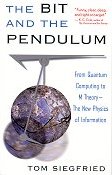I nearly didn't bother to read this book.
I started reading it soon after it first came out, and gave up after the first chapter. It seemed more pop than culture. But then I discovered that a colleague of mine recommends it as background reading for a course he is giving on quantum computing, and he told me it got better. So I tried it again. I was again ready to give up after the first chapter, but I persevered. (I used to be more persevering, but am less so now -- so many books, so little time to waste on potentially worthless ones.) And indeed it does get better. The froth that irritated me in the first chapter is much diluted subsequently. I think the start has been made a bit frothy in an attempt to "hook" the readership before things get heavy -- but it so very nearly had the opposite effect on me.
It uses the theme of information to link chapters on quantum computing and teleportation, DNA computing, cognition, complexity, black hole entropy, and String Theory. The author is a science journalist with a physics background, who interviews the key players in all the relevant areas, and weaves their stories together into an interesting whole. That whole is the idea that information itself could be the thing that underlies physical reality: Wheeler's "It from Bit". Each area is lucidly explained (for example, I think his explanation of other "goblin worlds" is clearer than Gell-Mann's own) and the links to the underlying information theme clearly set out.
Some of the issues are a little more subtle than they appear. For example, consider:
In a sense, this is true. But it isn't quite that simple: the real world is "open", and it is not always clear just what the information is. Take that apparently simple "ink on paper". What should be encoded as 1s and 0s? The words (assuming it is writing, and not a diagram, picture, or scribble)? Any crossed-out words? The style of writing (simple letters, beautiful copperplate hand, illegible scrawl, ...)? The size of the letters? The gaps between the letters? The colour and composition of the ink? The weight of the paper? The pattern of creases in the paper? Any little holes punched through the paper? The watermark? Any fingerprints or coffee mug rings? The chemical composition of perfume added afterwards? ... All these other "covert channels", and more, offer the possibility of conveying information. So just where do you stop when expressing it as 1s and 0s? It depends on what you consider to be the information. Yet, if you decide that creases are important after you have digitised the ink composition and thrown the paper away, well, that's too bad. You can digitise any particular information, but the real world always has something else extra up its sleeve. Unless you digitise everything -- the composition and position (and velocity, and higher derivatives, and quantum excitation state, and...?) of every atom.
But that's just a quibbling aside. Siegfried does a good job of explaining the various issues, enlivened by illuminating and entertaining quotes from the various scientists, such as
So, skim the first chapter, then settle down and enjoy the rest.
